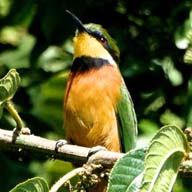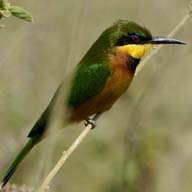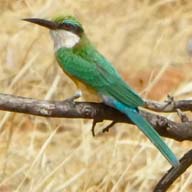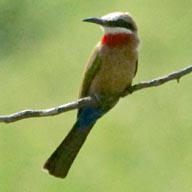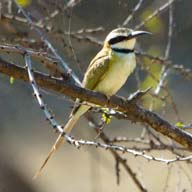
ComingsBirds.com/Birdgroups-A-F
To the Beauty of Birds
The bee-eaters are a group of near-passerine birds in the family Meropidae. Most species are found in Africa and Asia but others occur in southern Europe, Australia, and New Guinea. They are characterized by richly colored plumage, slender bodies, and usually elongated central tail feathers. All have long downturned bills and pointed wings, which give them a swallow-like appearance when seen from afar. There are 26 different species.
As the name suggests, bee-eaters predominantly eat flying insects, especially bees and wasps, which are caught in the air by sallies from an open perch. While they pursue any type of flying insect, honey bees predominate in their diet. Hymenoptera (ants, bees and wasps) comprise from 20% to 96% of all insects eaten, with honey bees comprising approximately one-third of the Hymenoptera.
Before eating its meal, a bee-eater removes the stinger by repeatedly hitting and rubbing the insect on a hard surface. During this process, pressure is applied to the insect thereby extracting most of the venom. Notably, the birds only catch prey that are on the wing and ignore flying insects once they land.
Bee-eaters are gregarious. Most of the species in the family are monogamous, and both parents care for the young, sometimes with the assistance of other birds in the colony, a behavior considered unusual for birds.
The bill can bite strongly, particularly at the tip, and is used as a pair of forceps with which to snatch insects from the air and crush smaller ones. The short legs have weak feet, when moving on the ground its gait is barely more than a shuffle. The feet have sharp claws used for perching on vertical surfaces and also during nest excavation.
The plumage of the family is generally very bright and in most species dominated or at least partly green. There is little visible difference between the sexes in most of the family.
Bee-eaters are fairly catholic in their habitat. Their requirements are simply an elevated perch from which to watch for prey and a ground substrate in which to dig their breeding burrow. Because their prey is entirely caught on the wing they are not dependent on any vegetation type.
They are a highly social family. Pairs sitting together are often so close together that they touch (described as having an individual distance of zero). Groups may roost together in a row in such a fashion as well.
The social structures of the Red-throated Bee-eater and the White-fronted Bee-eaters have been described as "the most complex of any bird species anywhere in the world". The birds exist in stable colonies located on nesting cliffs, and have a stable structure year round. These colonies are composed of clans of two or three pairs, their helpers, and offspring. Within the colony the males alternate between guarding their mate and attempting to make forced copulations with other females. The females in turn attempt to lay eggs in their neighbour's nests. Within colonies some individuals also specialise in kleptoparasitism, stealing prey collected by other colony members.
Bee-eaters spend around 10% of their day on what are known as comfort activities. These include sunning themselves, dust bathing and water bathing. Sunning behavior helps warm birds in the morning, reducing the need to use energy to raise the temperature. It also has a social aspect, as multiple birds adopt the same posture. Finally, it may help stimulate parasites in the feathers, making them easier to find and remove. Due to their hole-nesting bee-eaters accumulate a number of ectoparasites such as mites and flies. Together with sunning, bouts of dust bathing (or water bathing where available), as well as rigorous preening, keep the feathers and skin in good health.
Genus: Nyctyornis
Red-bearded Bee-eater, Nyctyornis amictus
Blue-bearded Bee-eater, Nyctyornis athertoni
Genus: Meropogon
Purple-bearded Bee-eater, Meropogon forsteni
Genus: Merops
Little Bee-eater, Merops pusillus
Blue-cheeked Bee-eater, Merops persicus
Green Bee-eater, Merops orientalis
White-throated Bee-eater, Merops albicollis
Swallow-tailed Bee-eater, Merops hirundinaeus
Blue-tailed Bee-eater, Merops philippinus
Black Bee-eater, Merops gularis
Blue-headed Bee-eater, Merops muelleri
Blue-moustached Bee-eater, Merops mentalis
Red-throated Bee-eater, Merops bulocki
White-fronted Bee-eater, Merops bullockoides
Blue-breasted Bee-eater, Merops variegatus
Cinnamon-chested Bee-eater, Merops oreobates
Black-headed Bee-eater, Merops breweri
Somali Bee-eater, Merops revoilii
Böhm's Bee-eater, Merops boehmi
Blue-throated Bee-eater, Merops viridis
Olive Bee-eater, Merops superciliosus
Rainbow Bee-eater, Merops ornatus
European Bee-eater, Merops apiaster
Chestnut-headed Bee-eater, Merops leschenaulti
Rosy Bee-eater, Merops malimbicus
Northern Carmine Bee-eater, Merops nubicus
Southern Carmine Bee-eater, Merops nubicoides

